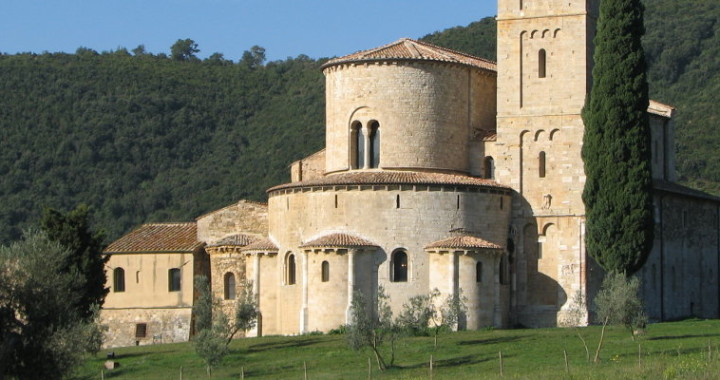A.M. Montalcino
Duration: 70 minutes – Tour Topics and Highlights: History, architecture, Brunello wine.
The medieval town of Montalcino remains unchanged since the 16th century. The town and fortress crown a hilltop where a walk on the ramparts offer a wide view over its 1500 vineyards dedicated to the world famous Brunello wine, considered to be the best among red Italian wines. Did you know? During the last Sunday of October in Montalcino there is the “Sagra del Tordo” an archery competition preceded by an impressive medieval costume procession. Recommended add-on: Sant’Antimo Abbey(see the following description) Sant’Antimo Abbey Duration: 30 minutes – Tour Topics and Highlights: History, architecture.
One of Tuscany’s most perfectly intact Romanesque churches, the stunning Sant’Antimo abbey, built of alabaster, sits in its own little valley of olive groves. Gregorian chants can still be heard daily, and the Sunday chants are the finest to be heard in the area. Did you know? Gregorian chants can still be heard daily at 9:00 a.m. ,2:30 p.m. and 6:30 p.m. except on Sundays at 11:00 a.m. (2:30 p.m. and 6:30 p.m.)
P.m. pienza
Duration: 70 minutes – Tour Topics and Highlights: History, architecture, urban planning
Built on a hill that dominates the Val d’Orcia, in the southern Siena’s province, Pienza is a completely intact, elegant Renaissance town, proclaimed a UNESCO World Heritage of Humanity site (1996) for its important example of Renaissance urban planning, architecture and monuments. Pope Pius II (Enea Silvio Piccolomini), a great humanist, commissioned his native village of Corsignano to be transformed from a medieval town to a splendid Renaissance city. Built of local yellow-ochre and white travertine stone, the pedestrian town of Pienza was designed by one of the most famous Florentine architects of his time, Bernardo Gambarelli known as the Rossellino, and built between 1459 and 1462. The itinerary includes the exceptional Cathedral, whose Renaissance façade hides a gothic interior Piazza Pio II and urban planning review Palazzo Piccolomini and Palazzo Borgia’s courtyards the Renaissance buildings the medieval districts the panoramic streets, from where the splendid landscape of the Val d’Orcia can be admired.


